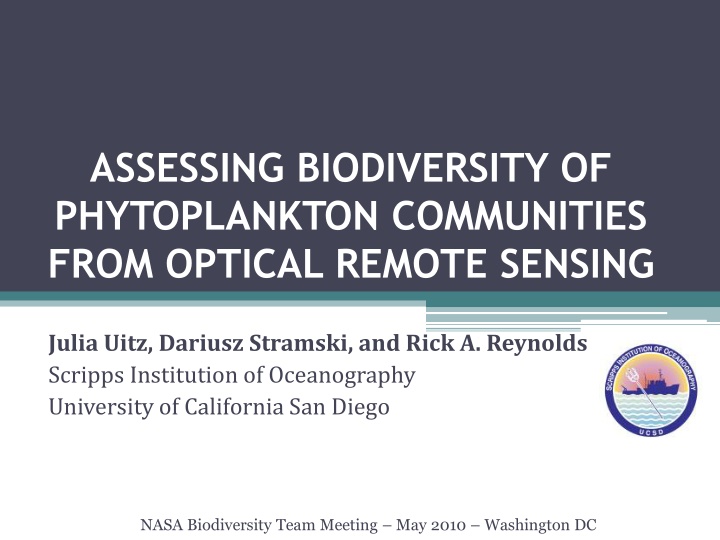
Assessing Phytoplankton Biodiversity Through Optical Remote Sensing
This research explores the importance of studying phytoplankton diversity using optical remote sensing to understand biogeochemical processes and marine ecosystems. The project aims to assess phytoplankton communities using current and hyperspectral approaches, focusing on ocean color-based discrimination and primary production modeling at different phytoplankton group levels.
Download Presentation

Please find below an Image/Link to download the presentation.
The content on the website is provided AS IS for your information and personal use only. It may not be sold, licensed, or shared on other websites without obtaining consent from the author. If you encounter any issues during the download, it is possible that the publisher has removed the file from their server.
You are allowed to download the files provided on this website for personal or commercial use, subject to the condition that they are used lawfully. All files are the property of their respective owners.
The content on the website is provided AS IS for your information and personal use only. It may not be sold, licensed, or shared on other websites without obtaining consent from the author.
E N D
Presentation Transcript
ASSESSING BIODIVERSITY OF PHYTOPLANKTON COMMUNITIES FROM OPTICAL REMOTE SENSING Julia Uitz, Dariusz Stramski, and Rick A. Reynolds Scripps Institution of Oceanography University of California San Diego NASA Biodiversity Team Meeting May 2010 Washington DC
2 WHY STUDYING PHYTOPLANKTON DIVERSITY? Phytoplankton diversity influences many important biogeochemical processes Photosynthetic efficiency Fate of carbon fixed via photosynthesis Marine biological pump of carbon Key questions to be addressed Understanding of marine biogeochemical cycles and modeling capabilities Distribution and variability on scales relevant to environment and climate changes
3 PROJECTOBJECTIVESANDSTRATEGY 1. Exploit current Chla- based approach Phytoplankton diversity in the world s open oceans from optical remote sensing 2. Explore the potential of hyperspectral approach
4 OCEAN-COLORBASEDDISCRIMINATIONOF DIFFERENTPHYTOPLANKTONGROUPS Satellite measurements of ocean color Surface Chla concentration Quasi-global spatial scale Daily to decade New generation of algorithms for discriminating different phytoplankton groups from ocean color Dominance (Alvain et al. 2005) Surface Chla (Devred et al. 2006; Hirata et al. 2008) Vertical profile of Chla (Uitz et al. 2006)
5 OCEANCOLOR-BASEDPRIMARYPRODUCTIONMODEL P(t,z) = Chla(z,t) a*(z,t) PAR(z,t) c(z,t) Absorbed light energy Conversion to C P: Primary production (g C m-3 d-1) PAR: Irradiance available for photosynthesis (mol quanta m-2 s-1) Chla: Concentration of chlorophyll a (mg m-3) a*: Chla-specific absorption coefficient of phytoplankton [m2 (mg Chla)-1] c: Quantum yield of carbon fixation [mol C (mol quanta)-1]
6 PRIMARYPRODUCTIONATTHE PHYTOPLANTKONGROUPLEVEL Ppg(t,z) = Chlapg(z,t) apg*(z,t) PAR(z,t) c,pg(z,t) Group-specific profiles of Chla (Uitz et al. JGR 2006) Group-specific photophysiology (Uitz et al. L&O 2008) Group-specific primary production (Uitz et al. GBC in press)
7 METHODOLOGY Ppg(t,z) = Chlapg(z,t) apg*(z,t) PAR(z,t) c,pg(z,t) (mg m-3) 10-year time series of SeaWiFS surface Chl (1997-2007) 1. Computation of Chla vertical profiles from surface Chla(Uitz et al. 2006) Chlamicro Chlanano Chlapico 2. Bio-optical model of Morel (1991) + photophysiological properties of Uitz et al. (2008) micro nano pico 3. Computation of group-specific primary production rates (Uitz et al. GBC in press) Pmicro Pnano Ppico
8 GLOBAL ANNUAL PRIMARY PRODUCTION Total primary production Pmicro + Pnano + Ppico = 46 Gt C y-1 Consistent with previous estimates (37-56 Gt C y-1; e.g. Antoine et al. 1996; Behrenfeld & Falkowski 1997; Westberry et al. 2008) Group-specific primary production Pmicro (diatoms) 15 Gt C y-1 (32% of total) Pnano(prymnesiophytes) 20 Gt C y-1(44%) Ppico(cyanobacteria) 11 Gt C y-1(24%) Carbon export towards deep oceans 10-16 Gt C y-1(20-40%; review by Tr guer et al. 2003)
9 CLIMATOLOGY OF MICROPHYTOPLANKTON PRODUCTION Boreal winter/Austral summer (Dec-Jan-Feb) Boreal summer/Austral winter (Jun-Jul-Aug) Temp/subpolar latitudes in summer: high contribution (e.g. Atl Nord >50%) Near-coastal upwelling systems: 70% (1 g C m-2 d-1) South Pacific Subtropical Gyre: Minimum contribution (0.02 g C m-2 d-1)
10 CLIMATOLOGY OF PICOPHYTOPLANKTON PRODUCTION Boreal winter/Austral summer (Dec-Jan-Feb) Boreal summer/Austral winter (Jun-Jul-Aug) Maximum contribution in oligotrophic subtropical gyres (40-45%) Contribution reduced to ~15% at high latitudes
11 CLIMATOLOGY OF NANOPHYTOPLANKTON PRODUCTION Boreal winter/Austral summer (Dec-Jan-Feb) Boreal summer/Austral winter (Jun-Jul-Aug) Substantial contribution on global scale: 0.07-1 g C m-2 d-1 (30-60%) Can be found in extremely diverse environmental conditions (subtropical gyres vs. winter subantarctic waters Biodiversity? (see Liu et al. PNAS 2009)
12 CONCLUSIONS AND PERSPECTIVES First climatology of phytoplankton group-specific primary production on global scale over seasonal to interannual scales Significant contribution to our ability to understand and quantify marine carbon cycle with implications for carbon export Key elements required to calibrate/validate new biogeochemical models (e.g. Le Qu r et al. 2005) Benchmark for monitoring responses of marine pelagic ecosystems to climate change
13 CONCLUSIONS AND PERSPECTIVES Chla-based approaches Describe general trends across various trophic regimes But do not necessarily account for specific local conditions New complementary approaches need to be developed Explore the potential of hyperspectral optical measurement for discriminating different phytoplankton groups Hyperspectral optical measurements have matured into powerful technologies in the field of remote sensing Yet remain largely unexplored for open ocean applications
14 HYPERSPECTRAL OPTICAL APPROACH -Input dataset- Optical measurements (ocean reflectance and absorption spectra) -Input dataset- Pigment composition Pilot study Small set of stations from Eastern Atlantic open ocean HPLC pigments Optical data Encouraging results Best classification with hyperspectral derivative spectra Derivative analysis Cluster analysis -Reference classification- Cluster analysis Evaluation of performance (Torecilla et al. in prep.)
15 HYPERSPECTRAL OPTICAL APPROACH 2nd cruise in the Atlantic Ocean almost completed!
16 THANK YOU FOR YOUR ATTENTION






















